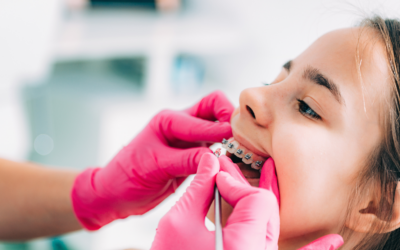Teeth that work together make it possible to bite and chew properly, and contribute to clear speech. Teeth that function well will tend to have a pleasing appearance. The beautiful smile that results from orthodontic treatment is the outward sign of good oral health, and sets the stage for overall well-being. Learn more here about baby teeth and permanent teeth.
Baby teeth begin to emerge in infancy, but they are already there at birth. Most children have their full set of 20 baby teeth around age 3. Usually the bottom front teeth are the first to appear, and the first to be lost.
Why should we care about baby teeth if they are just going to fall out?
Baby teeth are important to your child’s development. Even though the time will come that they will fall out, they are far from “disposable.” Baby teeth, also called primary or deciduous teeth, contribute to your child’s facial development, as well as the ability to bite, chew and speak. Baby teeth hold space for the permanent teeth that succeed them. Even baby teeth can decay, so limit or avoid sugary and/or acidic liquids (regular and diet soda pop, fruit juices, sports drinks), especially before bedtime.
When should I start brushing my child’s teeth?
Begin dental hygiene in infancy. Clean your baby’s gums with a soft, damp cloth after meals, and continue the practice as teeth begin to emerge. Help your toddler brush his teeth twice a day, and begin daily flossing when two teeth touch. Take your child to the dentist for a check-up after the first tooth appears, but no later than the first birthday. Keep up regular dental appointments so baby teeth stay healthy and in place until it’s time for permanent teeth to come in.
My child’s baby teeth have big spaces between them. Is that OK?
Yes. In general, space between baby teeth is a good thing. It indicates there should be room for permanent teeth to come in. But if you have concerns about your child’s teeth or jaws, check with an
AAO orthodontist for an expert opinion. A referral is not required. Many AAO orthodontists provide free or low-cost initial visits.
My child’s baby teeth are crowded. Is that OK?
No. This could be an early sign of something an orthodontist should monitor. You may wish to take your child to an
AAO orthodontist for a check-up.
My child sucks his thumb/finger/pacifier. Should I be concerned?
Prolonged sucking exerts force on the teeth and on the bone that supports the teeth. If your child sucks a thumb, finger, pacifier, lips, or fabric such as clothing or a blanket beyond age 4, there could be unwanted consequences. Teeth may be pushed forward, an open bite may develop, and bone may become misshaped.
My child’s front teeth stick out. Should we see an orthodontist?
Yes. Protrusive front teeth may be the outward sign of a problem with the positions of the jaws, or positions of the teeth, even if your child has baby teeth. Protrusive upper front teeth are more likely to be broken at play or in an accident. Consult an
AAO orthodontist.
My child’s baby teeth came out early. Why is that considered a problem?
A child’s mouth needs baby teeth to hold space for permanent teeth. Without baby teeth, permanent teeth may not come in properly, and facial development can be affected. See an
AAO orthodontist to learn what early loss of baby teeth means for your child.
Around age 6, children begin to lose baby teeth, and their first permanent molars appear. Permanent teeth begin to form before birth. Around age 13, most children have 28 of their permanent teeth. The third molars, known as “wisdom teeth,” appear in the late teen years, or early 20s. Sometimes a child may have too few permanent teeth. This is called “congenitally missing teeth.” The opposite can occur, and a child may have extra teeth, known as “supernumerary teeth.” Both conditions happen more often than you might imagine. Both can be diagnosed using a panoramic x-ray. An
AAO orthodontist can help to successfully manage these problems.
Signs that the Bite’s Not Right
If you notice any of these signs, consult an AAO orthodontist:
- Early or late loss of baby teeth
- Difficulty in chewing or biting
- Mouth breathing
- Jaws that shift or make sounds
- Speech difficulties
- Biting the cheek or the roof of the mouth
- Facial imbalance
- Grinding or clenching of teeth
My child doesn’t seem to be able to close her mouth all the way. Is that a problem?
It could be. When a person can’t comfortably keep their lips together when the mouth is closed and at rest, the condition is called “lip incompetence.” This can affect facial muscles, which could alter facial development. There may be problems with swallowing, jaw joint function, and the way teeth come in. See an
AAO orthodontist for an evaluation.
It seems like my child’s permanent teeth are late coming in. Should we see the dentist or the orthodontist?
See an
AAO orthodontist to learn whether there is a reason your child’s permanent teeth are late coming in. Orthodontists look at teeth differently than your dentist does. Something may be blocking the path of unerupted permanent teeth, they may be missing090, or it may simply be that your child is on his/her own schedule and there’s nothing to worry about. To see an orthodontic specialist, you do not need a referral from your general or pediatric dentist.
I noticed that when my son bites a hot dog, he uses his side teeth to bite instead of using his front teeth. Is this a sign of an orthodontic problem?
Yes. If someone cannot bite with their front teeth, called “incisors,” which are engineered to cut (“incise”) food, this can be a sign of an orthodontic problem. The upper and lower jaws could be out of balance and/or the front teeth could be protruding. See an
AAO orthodontist for an in-person evaluation.
What happens if orthodontic problems are not treated?
Generally, untreated orthodontic problems may become worse. Lack of orthodontic treatment can be a factor in tooth decay, gum disease, destruction of the bone that holds teeth in place, tooth loss, chewing/digestive difficulties, or abnormal wearing away of tooth enamel. Ultimately, orthodontic treatment may cost less than the restorative treatment that could be needed to treat decayed, worn or lost teeth, or gum disease.



